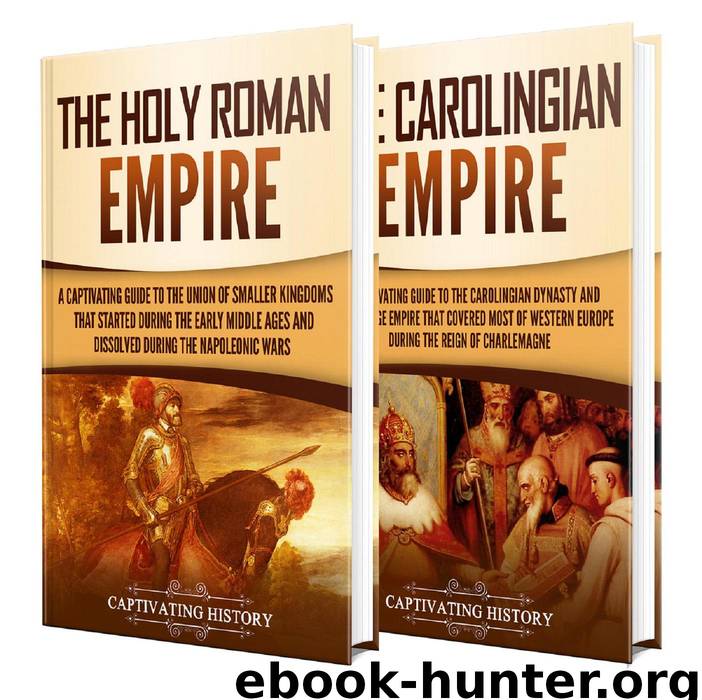Holy Roman Empire: A Captivating Guide to the Holy Roman Empire and Carolingian Dynasty by Captivating History

Author:Captivating History
Language: eng
Format: epub
Publisher: Captivating History
Published: 2019-09-10T16:00:00+00:00
Part 2: The Carolingian Empire
A Captivating Guide to the Carolingian Dynasty and Their Large Empire That Covered Most of Western Europe During the Reign of Charlemagne
Introduction
One of the few names to emerge from the Dark Ages to live on today is that of Charlemagne. After the fall of Rome, Western Europe was in almost complete disarray for several centuries, with different tribes and factions running different parts of the continent. Then, in 768 CE, Charles the Great, more commonly known as Charlemagne, became the ruler of the Franks.
The Carolingian Empire was an empire in much the same way as the Holy Roman Empire was—in fact, it covered most of the same parts of Europe. Charlemagne was able to build a much more coherent empire that he controlled, while the Holy Roman Empire was more of a collective of principalities that were only loosely united under the Holy Roman Emperor. However, the Holy Roman Empire lasted for more than several centuries, while the Carolingian Empire didn’t last for more than a few decades after Charlemagne’s death. Even more interesting, some historians say that the Holy Roman Empire began with Charlemagne and lasted until 1806.
While there is plenty of debate about how these two empires are connected, what is certain is how the Carolingian Empire began. Germanic tribes had used the time that they served in the Roman military to carve out their own territories once Rome fell. Then Charlemagne came to power, taking control of the Franks after his father died. Initially, he was meant to have shared control of the Frankish kingdom with his brother, but Charlemagne did not want to relinquish control or share it with anyone else. His brother stepped aside, and this gave Charlemagne all of the power he needed to expand the kingdom well beyond what his father had controlled.
Just when the empire began is also debatable. Some historians put the beginning of the Carolingian Empire at around 800 CE, while others put it closer to 751 CE. The discrepancies stem (at least in part) from what is considered to be an empire. Charlemagne took over the Frankish kingdom in 768, so in 751, the region was still under the control of his father, and numerous kingdoms still covered the areas that eventually became part of the Carolingian Empire. Pope Leo III declared Charlemagne emperor on December 25, 800, which is why this date is sometimes cited as the beginning of the empire.
The reason that Charlemagne’s name has remained so familiar despite more than a millennium since his death is because of the long-term effect his time as emperor had over Western Europe. After uniting a large swath of Western Europe under his control, Charlemagne divided the regions into 52 distinct areas, each of which was run by a count. These counts were not left to run their respective areas without oversight, though, with missi dominici assigned to ensure that those in power did not abuse their rules.
Charlemagne did continue the system founded under Charles Martel (or Charles the Hammer), which ensured a class structure that favored the wealthy few.
Download
This site does not store any files on its server. We only index and link to content provided by other sites. Please contact the content providers to delete copyright contents if any and email us, we'll remove relevant links or contents immediately.
| Africa | Americas |
| Arctic & Antarctica | Asia |
| Australia & Oceania | Europe |
| Middle East | Russia |
| United States | World |
| Ancient Civilizations | Military |
| Historical Study & Educational Resources |
Journey to the Abyss by Harry Kessler(1343)
Armor and Blood by Dennis E. Showalter(942)
Hitler 1889-1936: Hubris by Ian Kershaw(863)
The Celestine Prophesy by James Redfield(809)
The Cello Suites by Eric Siblin(768)
1989 by Peter Millar(729)
Albert Speer: His Battle With Truth by Gitta Sereny(685)
Journey to the Abyss: The Diaries of Count Harry Kessler, 1880-1918 by Harry Kessler(667)
1938 by Giles MacDonogh(549)
Einstein in Berlin by Thomas Levenson(538)
The First and the Last by Adolf Galland(526)
DK Eyewitness Travel Guide Germany by DK Travel(524)
Hitler by Unknown(508)
Germany (Lonely Planet, 6th Edition) by unknow(467)
Grey Wolf: The Escape of Adolf Hitler by Simon Dunstan & Gerrard Williams(464)
Unholy Alliance: A History of Nazi Involvement With the Occult (New and Expanded Edition) by Peter Levenda(442)
The Nazis – A Warning from History by Laurence Rees(401)
Hitler Youth by Susan Campbell Bartoletti(401)
Groundwork for the Metaphysics of Morals by Immanuel Kant(391)
